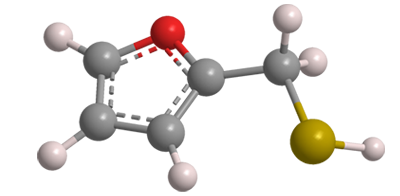What molecule am I?


2-Furfurylthiol, which also goes by 2-furanmethanethiol, furfuryl mercaptan, and many other names, is an oily organic liquid that is best known as the principal odor component of roasting and brewing coffee.
In the late 1920s, a series of patents, primarily by noted organic chemist Hermann Staudinger1 at the University of Freiburg (Germany), described syntheses of 2-furfurylthiol. In a 1928 Canadian patent, Staudinger and co-inventor Thadeus Reichstein treated furfural with ammonium hydrogen sulfide (NH4HS) to make bis(furylmethyl) disulfide, which they then then reduced to the thiol. In a Swiss patent the same year, these inventors cited sodium sulfide and elemental zinc, aluminum, and sodium as useful reducing agents.
In a 1955 article in Organic Syntheses, Helmer Kofod at the Danish Pharmaceutical College (Copenhagen) described a synthesis of 2-furfurylthiol via the acid-catalyzed reaction of furfuryl alcohol and thiourea to produce an isothiouronium intermediate, which liberates the free thiol upon base hydrolysis.
In 1944, José Giral and Aureliano García Fernández at the University of Nuevo León (Monterrey, Mexico) were likely the first to identify 2-furfurylthiol with coffee aroma. Six years later, Staudinger and Reichstein, along with Staudinger’s son Hansjürgen, published a review of patents that covered the use of the thiol as a coffee-flavoring agent.
The Food and Agriculture Organization of the United Nations describes 2-furfurylthiol thus: “colourless oily liquid; extremely powerful and diffusive odour which on dilution becomes agreeable, coffee-like, caramellic-burnt, sweet”. In other words, the seemingly nasty compound described in the hazard information table becomes appealing when sniffed in small quantities.
Happy new year from the Molecule of the Week team—and we hope that smelling the aroma of 2-furfurylthiol on January 1 helped you wake up to the brand-new year.
1. Staudinger was awarded the 1953 Nobel Prize in Chemistry for his pioneering work on polymers.
2-Furfurylthiol hazard information
| Hazard class* | GHS code and hazard statement | |
|---|---|---|
| Flammable liquids, category 3 | H226—Flammable liquid and vapor | |
| Acute toxicity, oral, category 4 | H302—Harmful if swallowed | |
| Acute toxicity, dermal , category 4 | H312—Harmful in contact with skin | |
| Serious eye damage/eye irritation, category 2A | H319—Causes serious eye irritation | |
| Acute toxicity, inhalation, category 3 | H331—Toxic if inhaled | |
| Specific target organ toxicity, single exposure, respiratory tract irritation, category 3 | H335—May cause respiratory irritation | |
*Globally Harmonized System (GHS) of Classification and Labeling of Chemicals. Explanation of pictograms.
This molecule was suggested by a reader. We present almost all of the molecules suggested by our readers. If you have a molecule you would like us to consider, please send us a message. And thank you for your interest in Molecule of the Week! —Ed.
2-Furfurylthiol fast facts
| CAS Reg. No. | 98-02-2 |
| SciFinder nomenclature | 2-Furanmethanethiol |
| Empirical formula | C5H6OS |
| Molar mass | 114.17 g/mol |
| Appearance | Colorless oily liquid |
| Boiling point | 155 °C |
| Water solubility | 0.5 g/L |
MOTW update
Lauric acid was one of the Molecules of the Week for May 7, 2018. It is a fatty acid, esters of which occur in natural substances such as coconut milk and palm kernel oil. A November 2021 market report on lauric acid states that its main use in manufacturing is as an ingredient in soaps and shampoos. Its global market size is expected to grow from US$605 million in 2020 to US$716 million by 2026.

Learn more about this molecule from CAS, the most authoritative and comprehensive source for chemical information.
Molecule of the Week needs your suggestions!
If your favorite molecule is not in our archive, please send us a message. The molecule can be notable for its current or historical importance or for any quirky reason. Thank you!
Stay Ahead of the Chemistry Curve
Learn how ACS can help you stay ahead in the world of chemistry.

